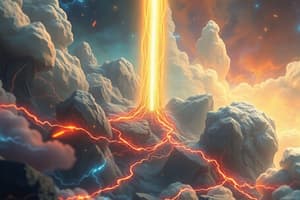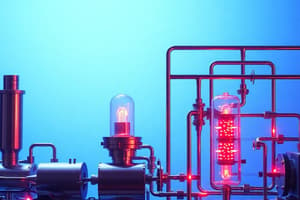Podcast
Questions and Answers
Which of the following statements accurately describes the Clausius statement of the Second Law of Thermodynamics?
Which of the following statements accurately describes the Clausius statement of the Second Law of Thermodynamics?
- The entropy of a closed system always increases over time.
- Heat cannot be transferred from a colder body to a hotter body without external work. (correct)
- The entropy of a perfect crystal at absolute zero temperature is zero.
- It is impossible to extract heat from a single reservoir and convert it entirely into work.
In which thermodynamic process does the volume of the system remain constant?
In which thermodynamic process does the volume of the system remain constant?
- Isobaric
- Cyclic
- Adiabatic
- Isochoric (correct)
Which of the following applications does NOT directly involve the principles of thermodynamics?
Which of the following applications does NOT directly involve the principles of thermodynamics?
- Developing new materials with specific heat transfer properties
- Designing a fuel-efficient internal combustion engine
- Predicting the weather patterns based on atmospheric conditions (correct)
- Analyzing the structure of proteins in a biological system
What is the primary difference between the Carnot cycle and the Rankine cycle?
What is the primary difference between the Carnot cycle and the Rankine cycle?
Which of the following statements BEST describes the ideal gas law (PV = nRT)?
Which of the following statements BEST describes the ideal gas law (PV = nRT)?
What is the term for the portion of the universe that interacts with the system being studied?
What is the term for the portion of the universe that interacts with the system being studied?
Which thermodynamic potential is particularly useful for constant-pressure processes?
Which thermodynamic potential is particularly useful for constant-pressure processes?
The first law of thermodynamics states that:
The first law of thermodynamics states that:
A thermodynamic process can be described as:
A thermodynamic process can be described as:
What is the relationship between heat (Q), work (W), and internal energy (U) according to the first law of thermodynamics?
What is the relationship between heat (Q), work (W), and internal energy (U) according to the first law of thermodynamics?
A system is said to be in equilibrium when:
A system is said to be in equilibrium when:
Which of the following is NOT a state variable in thermodynamics?
Which of the following is NOT a state variable in thermodynamics?
What does the zeroth law of thermodynamics imply?
What does the zeroth law of thermodynamics imply?
Flashcards
Second Law of Thermodynamics
Second Law of Thermodynamics
Describes the direction of thermodynamic processes; energy tends to disperse.
Kelvin-Planck Statement
Kelvin-Planck Statement
It is impossible to convert all heat from a heat source into work without some leftover heat.
Carnot Cycle
Carnot Cycle
Idealized thermodynamic cycle that sets efficiency limits of heat engines between two reservoirs.
Isothermal Process
Isothermal Process
Signup and view all the flashcards
Ideal Gas Law
Ideal Gas Law
Signup and view all the flashcards
Thermodynamics
Thermodynamics
Signup and view all the flashcards
System
System
Signup and view all the flashcards
Surroundings
Surroundings
Signup and view all the flashcards
Internal Energy (U)
Internal Energy (U)
Signup and view all the flashcards
Enthalpy (H)
Enthalpy (H)
Signup and view all the flashcards
Entropy (S)
Entropy (S)
Signup and view all the flashcards
First Law of Thermodynamics
First Law of Thermodynamics
Signup and view all the flashcards
Study Notes
Introduction to Thermodynamics
- Thermodynamics is the branch of physics that deals with heat, work, and temperature, and their relation to energy, entropy, and the physical properties of matter and radiation.
- It describes how macroscopic properties of a system, like temperature, pressure, and volume, change and relate to each other.
- Thermodynamic processes are governed by fundamental laws, which are broadly applicable across various scientific and engineering disciplines.
Key Concepts in Thermodynamics
- System: A defined region of the universe that is under study.
- Surroundings: The remaining portion of the universe that interacts with the system.
- Boundary: A real or imaginary surface separating the system from its surroundings.
- State variables: Properties that describe the condition of a system, such as temperature, pressure, volume, and internal energy.
- Process: A change in the state of a system.
- Equilibrium: A state where there are no unbalanced forces or gradients within a system.
- Internal Energy (U): The total energy stored within a system, including kinetic and potential energy of its molecules.
- Enthalpy (H): A thermodynamic potential that is particularly useful for constant-pressure processes (H = U + PV).
- Entropy (S): A measure of the disorder or randomness of a system.
- Heat (Q): Energy transferred between a system and its surroundings due to a temperature difference.
- Work (W): Energy transferred between a system and its surroundings without any temperature difference (e.g., mechanical work).
- Specific Heat Capacity: The heat required to raise the temperature of a unit mass of a substance by one degree.
The Laws of Thermodynamics
- Zeroth Law: If two systems are each in thermal equilibrium with a third, then they are also in thermal equilibrium with each other. This implies the existence of a well-defined temperature.
- First Law: Energy cannot be created or destroyed, only transferred or changed in form. The change in internal energy of a system is equal to the heat added to the system minus the work done by the system. (ΔU = Q – W).
- Second Law: The total entropy of an isolated system can never decrease over time. In spontaneous processes, the entropy of the universe increases. This law introduces concepts like irreversibility and the directionality of natural processes. There are several equivalent statements of the second law including the Kelvin-Planck statement and the Clausius statement. The second law is crucial in evaluating the feasibility of processes.
- Third Law: The entropy of a perfect crystal at absolute zero temperature is zero. This law helps define the absolute temperature scale (Kelvin scale).
Types of Thermodynamic Processes
- Isothermal: Constant temperature.
- Isobaric: Constant pressure.
- Isochoric: Constant volume.
- Adiabatic: No heat transfer.
- Cyclic: A process that returns the system to its original state.
Applications of Thermodynamics
- Engineering Design: Designing efficient engines, power plants, and refrigeration systems.
- Chemistry: Understanding chemical reactions, phase transitions, and equilibrium.
- Material Science: Studying the behavior of materials under different conditions.
- Biology: Analyzing biological systems and their energy transformations.
- Environmental Science: Modeling the flow of energy and resources in ecosystems.
Thermodynamic Cycles
- Carnot Cycle: A theoretical, idealized cycle representing the maximum possible efficiency of a heat engine operating between two heat reservoirs. Useful for understanding limits of efficiency and performance.
- Rankine Cycle: A cycle that describes the working principle of steam power plants.
- Otto Cycle: A cycle describing the thermodynamic processes in a typical internal combustion engine.
- Diesel Cycle: A cycle modeling a diesel engine's operation.
- Brayton Cycle: A cycle used in gas turbines.
Properties of Fluids and Their Thermodynamic Behavior
- Ideal Gas Law: PV = nRT, connecting pressure, volume, temperature, and the number of moles of an ideal gas.
- Real Gases: Deviation from ideal gas behavior under certain conditions (high pressure, low temperature) requiring more complex equations of state.
Studying That Suits You
Use AI to generate personalized quizzes and flashcards to suit your learning preferences.




